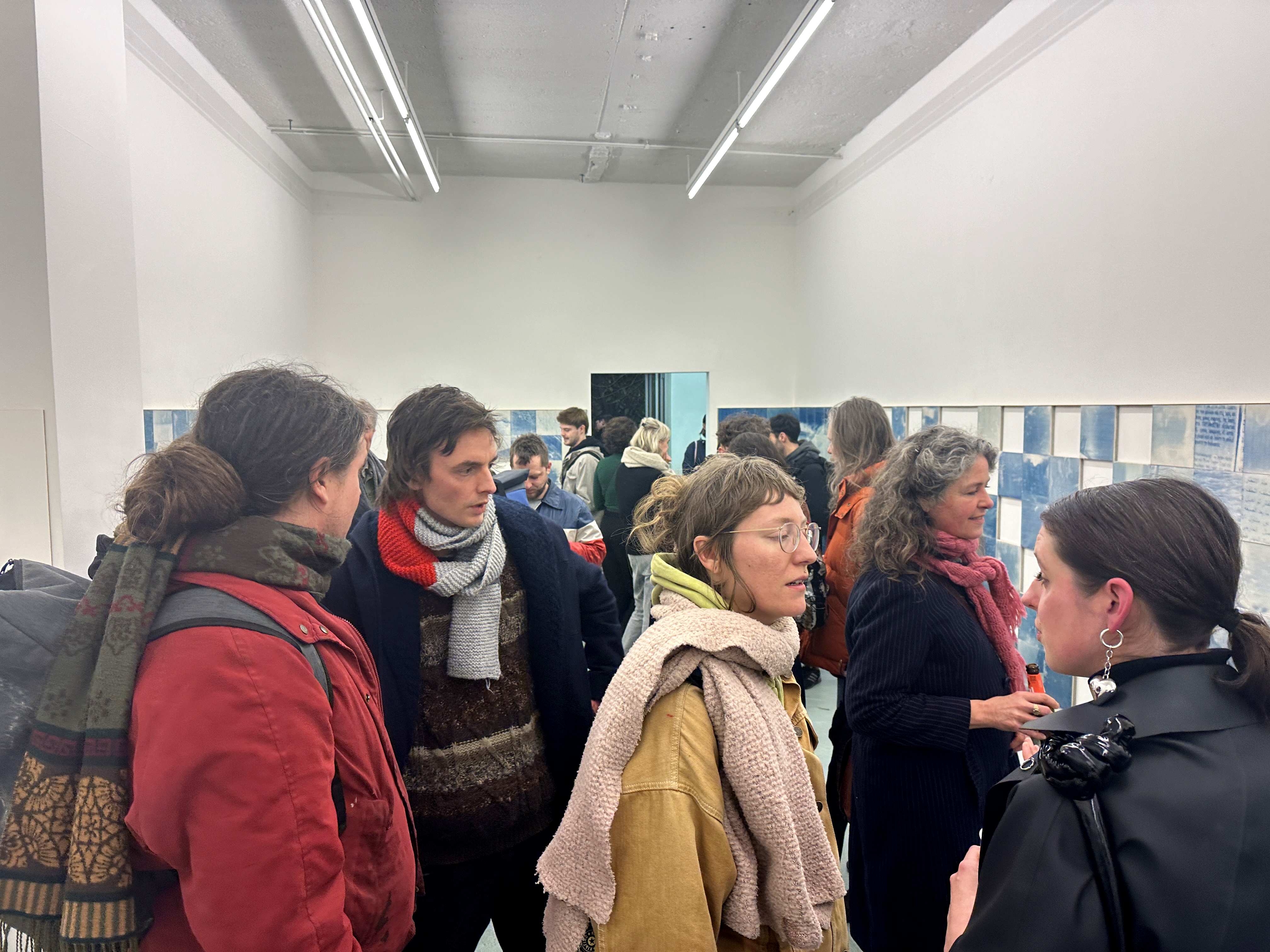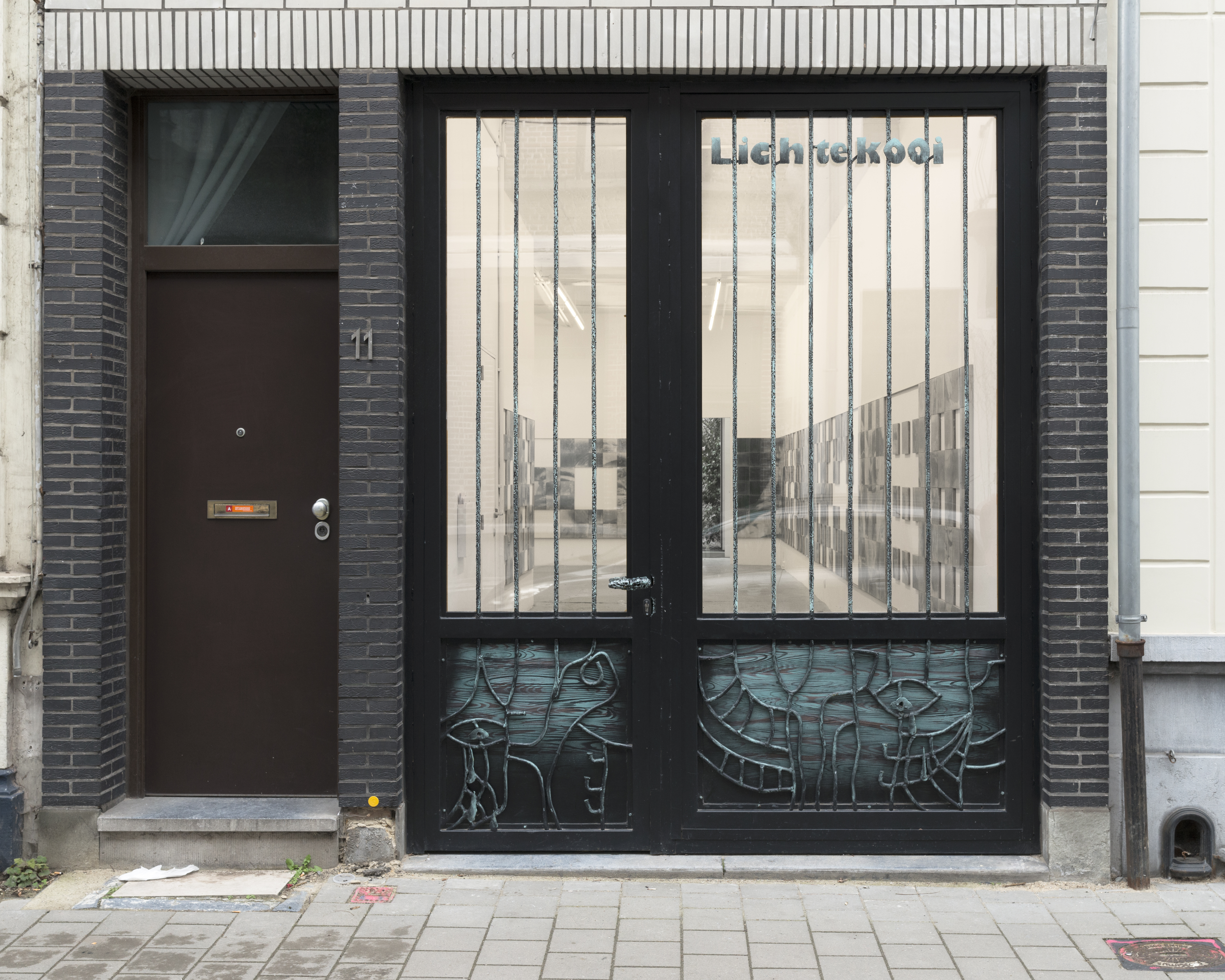Exh|bition![]()
![]()


Benjamin Verhoeven & Amine Lahrach
Deux mains fait demain
02.03.2024 - 20.04.2024
Much can be told about what precedes the tile and images of Amine Lahrach (Morocco, 1995) and Benjamin Verhoeven (Belgium, 1990) at Lichtekooi: about two different passports, a hairdresser, an archive of images, encounters, and moments especially without a camera in Marrakesh and recently also in Brussels and Antwerp. Their encounter and collaboration begins with Benjamin Verhoeven’s residency at LE 18 in October 2020 and the question of the legitimacy of “taking” photographs. The camera literally becomes a nuisance in the Medina of Marrakesh until the moment Amine takes over Benjamin’s camera: “He took my camera and started filming and taking pictures of objects, views, people, shots that I wanted to take as well. There was an exchange created between each other’s gazes and the question of the legitimacy of taking images took an interesting turn with Amine by my side.” The ubiquitous tiles in LE 18 provide a script for the exchange of ideas. The geometric patterns between the handmade Zellige tiles lead to a grid pattern on which they will project their shared images. In February 2023, they will present the video installation The Missing Piece. On 49 tiles, still and moving images alternate with handwritten notes that intersect the images along a line structure. It is a tool they also use at Lichtekooi for about 500 tiles, but now only during combining and composing, before the moment when they take images from the digital screen, for photography between the lines and at intersections.
The tile is the setting of an encounter. The image is evidence of what was seen by Amine and/or Benjamin. At the same time, it is a reinvention of what they have seen. This comes close to what Luigi Ghirri (1943–1992) has written about photography : “Essentially, photography does nothing but represent a person’s perceptions of the world. This includes all the enigmatic relationships and mysterious elements that remain in the photographic image.” He prefers the terms “enigmatic” and “mysterious” over “ambiguity.” Thirty years after the Italian photographer, Benjamin and Amine take their places behind a computer screen. The common, shared image is created by zooming in on fragments of photographs from their digital archive. The image on the screen is then photographed again with the camera. Blow-up becomes a technique for distorting and displacing the original camera viewpoint. The image that was seen is reinvented. This is not so much about process, the omniscient metaphor of modernism, as it is about exploring a space between two thumbs and index fingers.
The tile becomes the representation of a mental space at a given time. The image on the screen is moved again and again with the two hands of tomorrow. In this way, the multiplication of images seems to slow down, and who knows, is itself stopped for a moment. The movement makes the territory of the gaze have no defined boundaries. In the words of Amine and Benjamin, “All images, as unimportant or short as they seem, carry information in a world where every millisecond an image is created. They hold a bigger truth in them, a part of a bigger picture, that’s why we continue our pursuit through our camera, continue to shoot images and analyze them in a personal and in a relational way to arrive at the common image.” To this they link the idea that an image can exist in two or more places at the same time. These are images that they both share, recognize, and understand without having to have the same place (geographical location), knowledge, or culture. An image can exist in two or more places at the same time.
The tile is a projection surface. An image can consist of two or more fragments. An image can overflow on two or more tiles. And our shadows also appear on the tiles, overshadowing and illuminating part of the images each time. Ibn al-Haytham (965–1040) was the first scholar, already in the tenth century, to clearly understand, analyze, and use the principles of the camera obscura. The earliest description of this concept, as well as the principles of refraction of light, can be found in al-Haytham’s Kitab al Manazir (known in English as The Optics). The walls of the dark room are covered with tile.
The tile is worked by hand. There is nothing mysterious about the exact process, but a bit of alchemy remains hidden in Benjamin and Amine’s studio. Call it a mixture or an alliance between Elixir d’Anvers and Air de Bruxelles, la marocaine. They use a light-sensitive emulsion layer, a cyanotype or blue printing technique. The invention of this is credited to an astronomer, and cyanotype is also called solar printing. The tile is a cement tile.
The tile is an object for photography. The shutter made a clicking sound. The image is stored in a digital archive. In their collaboration and dialogue, Amine and Benjamin use the word “archive,” even though they are aware that at best it can provide no more than the illusion of a nonimperialist research source. Indeed, the archive selects, distorts, and almost always excludes much. It sounds somewhat crude to speak of archives in this way, but from the perspective of the tile, perhaps another door opens. Ariella Aïsha Azoulay (Palestine, 1962) writes: “Photography provides (if we do not actively repress it) a constant reminder of others with whom we share our world and who pose limits on our action by their very presence.” She then just pointed out that “we are often reminded of our inevitable participation in the reproduction of the triple imperial principle and its traps, set to ambush and lure us. One of these traps is made of the privileged opportunity given to some of us to single-handedly craft images of the world—or improve blueprints for its future—we share with others and seemingly succeed in changing or averting its course regardless of others’ actions." This lure and the ingrained ambush of an archive brimming with images played a major role in the conversations that preceded the exhibition Deux Mains Fait Demain. The realization that “the craft” of the image could be a problem from the start had come up earlier. Both artists remember the words of Mostafa Derkaoui (Morocco, 1944), the director of De quelques événements sans signification (1974), about how he always followed his desire to “replace the screen” (Derkaoui's film was censored in 1974 after one screening in Paris and did not return to circulation until 2019, after forty-five years). Was there a road to be traveled toward the “shared image” there? And was the search, the question itself, part of the ambush and lure?
The tile is a memory of a friend. The tile becomes part of the image, of a shared journey. Biographical data are still often dismissed as an encroachment on the autonomous work of art. At a specific spot in Marrakesh, Benjamin and Amine temporarily embedded a tile with a blueprint of their hands into an existing Zellige wall. Just a stone’s throw from LE 18, in Riad Dar Bleu. There, near the bench, a tile had come loose, and not much later a large void had also appeared. The tile on which the thumb and index finger of two hands touch is a reminder and a small homage to Hassan in Antwerp. The ten by ten centimeters in Dar Blue has now also been refilled with a tile from 2020. On it Benjamin writes: “Dear Hassan, a little reminder of evenings, dinners, mornings, time [...].”
About some additions that may be irrelevant. Luigi Ghirri made photographs for an Italian tile company for many years. The American composer Morton Feldman (1926–1987) wrote: “With Cézanne it is always how he sees that determines how he thinks, where the modernist, on the other hand, has changed perception by way of the conceptual. In other words, how one thinks has become the sensation.” The Moroccan filmmaker Ahmed Bouanani (1938–2011) predicted in 1986: “In this new decade, all along the corridor that strangely resembles the labyrinth of legends, we reveal the hidden face of the postcard, we begin a crossing of appearances, [...] we experience a new look, [...]. Over there, in front of us, an open door to the sky.” Three years later, in 1989, Farida Benlyazid (Morocco, 1948) releases her film Une Porte sur le Ciel, and another thirty-three years later, the collective LE 18 in Marrakesh quotes the same title for their public program and reception space during documenta fifteen in Kassel. They add a few words: A Door to the Sky - Or a Plea for Rain. Django is the name of the cat in Dar Blue.
Phillip Van den Bossche, 2024
Translation: Trevor Perri
Raadpleeg de NL zaaltekst hier
Exh|bition views Lichtekooi:












Artist talk Benjamin Verhoeven & Amine Lahrach: Le zamakan 7 sur 7 / زمكان. on 22.03.24:
Thanks to the artists, Dorian Baetens, Guillaume Bijl, Marijn Celea, Kris Cuylits, Simon Delobel, Chris Gillis, Laila Hida, Mohamed Ikoubaân, Juliet Jespers, Mustapha Lahrach & Khadija Chadili, Ismail Lahrach, Youssef Lahrach, Ulrike Lindmayr, Stella Lohaus, Joachim Naudts, Ula Neumann, Francesca Masoero, Rufus Michielsen, Ria Pacquée, Trevor Perri, Zuzanna Rachowska, Fabien Silvestre Suzor, Sarah Smolders, Hassan Soufiani, Patrick & Rina Verhoeven-Meurisse, Jolke Van Aerde, Tom Van Camp, Philippe Van den Bossche and Tamu & Rachida.
With the support of the Flemish government.
In collaboration with Le 18.

